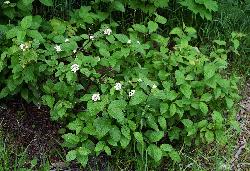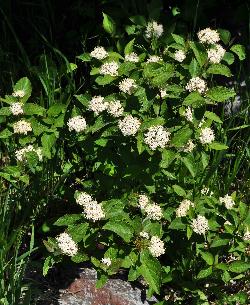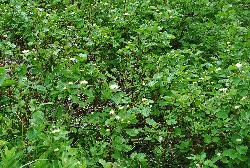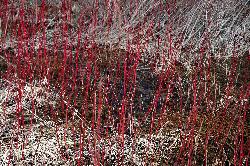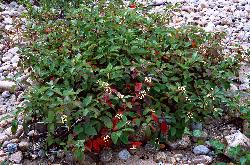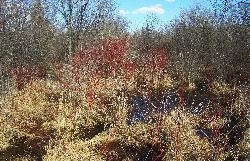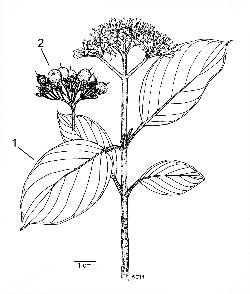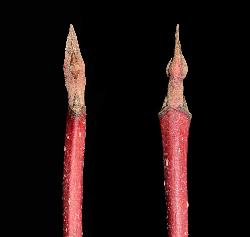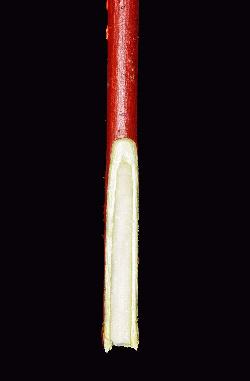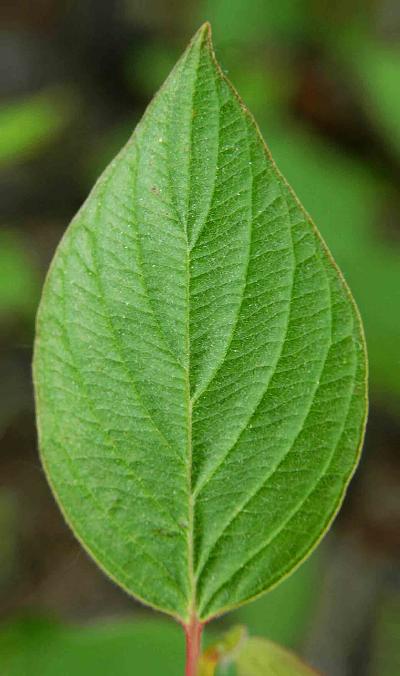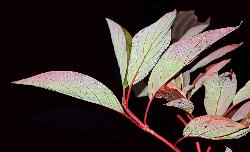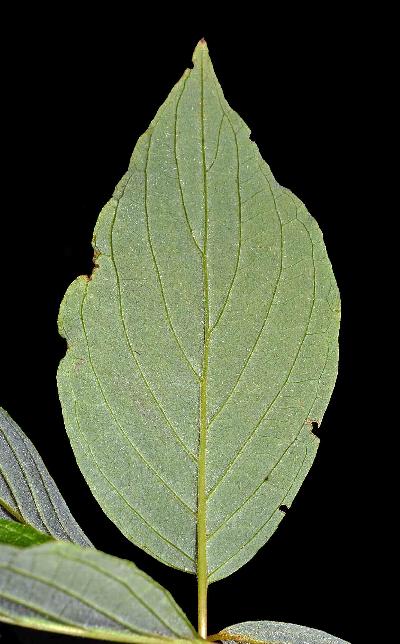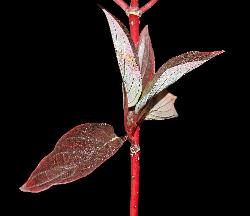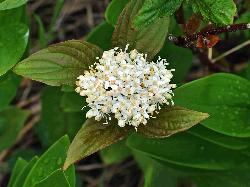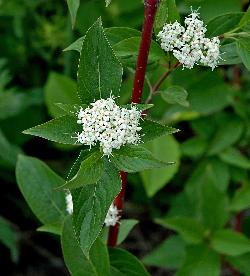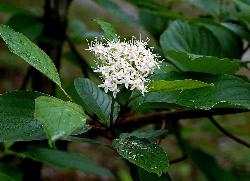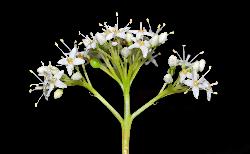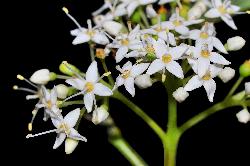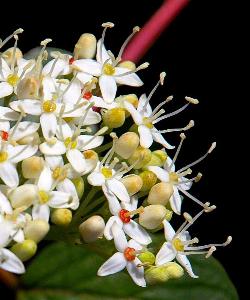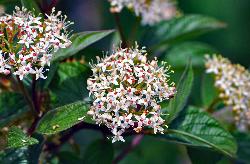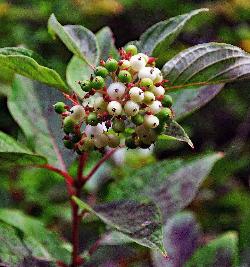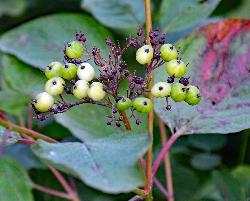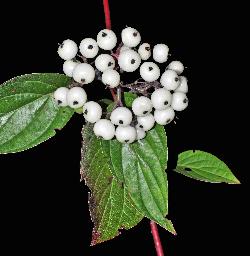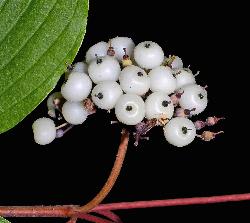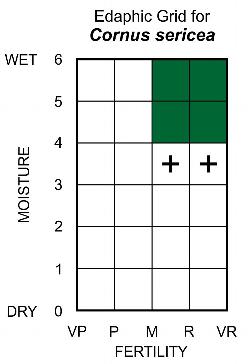Fr: cornouiller stolonifère, hart rouge, cornouiller hart-rouge
IA: mikuapemaku
Cornaceae - Dogwood Family
Note: Numbers provided in square brackets in the text refer to the image presented above; image numbers are displayed to the lower left of each image.
General: A spreading to erect, multi-stemmed deciduous shrub, 1–3 m tall [1-3], with bright red stems [4]; branching is opposite. Red-osier dogwood is stoloniferous and flood-tolerant; it is typically found in low wet habitats, such as stream and pond margins, sand dunes, sandbars, and nutrient-rich wet forests [5–6]. In these habitats, the shrubs spread by rooting of prostrate branches or root sprouts to form dense thickets. Red-osier dogwood provides browse for moose and small mammals, as well as cover or food (fruit) for a variety of small mammals and birds (Gucker 2012).
In many references, North American plants of red-osier dogwood are still referred to as Cornus stolonifera L., but recent examination of the Linnaean type specimen of Cornus sericea, previously considered a European species, has shown that these two names represent the same species; thus C. stolonifera is now listed as a synonym of C. sericea (Brouillet, pers. comm., Nov. 2016; FNA vol. 12, in prep.).
Key Features: (numbers 1–2 refer to the illustration [7], number 3 refers to image [4])
1. Leaves are opposite and pinnately veined with 5–7 pairs of arcuate veins that curve forward towards the apex of the leaf.
2. Fruits are white drupes with a black dot at the end, formed by the persistent nectar disk and style; fruits are borne on dark purple pedicels and arranged in branched
clusters.
3. Twigs are slender and bright to deep red [4]; the small buds are naked, lacking hard bud scales, and the pith is white.
Stems/twigs: Young stems are green to reddish and covered with fine hairs. Winter twigs are glabrous to finely hairy, usually bright red to deep purplish-red, with numerous small lenticels. Buds are opposite, pointed, reddish-brown, naked, and valvate; the reduced scale-like leaves of the buds are covered with short pale brown hairs [8–9]. Flower buds are terminal and can be recognized by the rounded bulge of the immature inflorescence between the two outer modified leaves [8]. Leaf scars are V-shaped, slightly raised, edged in black, and have 3 bundle trace scars [9]. The pith is large and white, and occupies about one half of the stem diameter [10]. Older branches are greenish brown to reddish-brown.
Leaves: Opposite, simple, pinnately-veined, with 5–7 pairs of arcuate veins that curve forward towards the leaf apex [11]; petioles are 0.6–2.5 cm long. Immature leaves are often tinged with bronze, but become green as they expand. Mature leaf blades are lanceolate, ovate, to elliptic, 5–15 cm long by 2.5–9 cm wide, dark green, glabrous to finely pubescent above with short appressed hairs, and dull to somewhat glossy; the lower surface is paler to glaucous [12], and finely hairy [13–14]. Leaf bases are tapering (cuneate) to rounded, apices are sharply pointed (acute), and margins are entire. Leaves turn purplish-red in autumn [15–16].
Flowers: Numerous and small, in flat-topped or domed branched inflorescences (compound cymes) [17–20]. Flowers have a minute 4-toothed calyx, 4 white petals, 4 exserted stamens that are longer than and alternate with the lanceolate petals, and a single pistil with an inferior ovary [21]. A pale nectar disk rings the base of the slender style [22–23], changing colour from pale orange to red after pollen is released [24]. Flowers bloom in early summer. Red-osier dogwood is an obligate outcrosser and pollinated by a variety of insects (entomophily), primarily bumblebees, but also syrphid flies, bee flies, or butterflies (Gucker 2012, Barrett and Helenurm 1986).
Fruit: A cluster of globose white berry-like drupes. Fruits mature from green to white in late summer and are borne on reddish pedicels that become dark purple at maturity [25–29]. Each fruit is 6–9 mm in diameter and contains a single 2-seeded stony pit. The drupes may be finely pubescent or glabrous, and are topped by a conspicuous black dot, formed by the persistent style and nectar disk (images 28-30). Dispersal is by mammals and frugivorous birds (endozoochory) that defecate or regurgitate the seeds after eating the fruit (Gucker 2012).
Ecology and Habitat: Red-osier dogwood occurs most frequently on moist to wet nutrient-rich lower seepage slopes and on the shorelines of small streams and ponds throughout Newfoundland and the southern half of Labrador. It colonizes the slopes of coastal dunes [3] or sand and gravel bars in streams [4]. Red-osier dogwood can survive in partial shade, but does best in open habitats. It can spread rapidly through root sprouting after disturbance by windthrow, harvesting, or fire. Its vertical growth is frequently suppressed by moose and rabbit browsing, but if left undisturbed, the shrubs can reach 2–3 m in height.
Edaphic Grid: See image [30]: the Edaphic Grid for Cornus sericea.
Forest Types: Red-osier dogwood is most frequent and abundant in the following forest types:
Abietum rubetosum (Rubus-Balsam Fir Forest Subassociation)
Aceretum spicatae (Mountain Maple Thicket Association)
Alneto Piceetum (Alder-Black Spruce Swamp Association)
Alnetum lycopodietosum (Lycopodium-Alder Swamp Subassociation)
Betuletum typicum (White Birch-Mountain Alder Forest Subassociation)
Caricio-Piceetum (Carex-Black Spruce Fen Association)
Osmundo-Piceetum (Osmunda-Black Spruce Fen Association)
Red-osier dogwood can also occur sporadically on dry sites underlain by calcareous bedrock, such as the Abietum taxetosum (Taxus-Balsam Fir Forest Subassociation), Abietum dryopteretosum-Rhytidiadelphus variant (Dryopteris-Rhytidiadelphus-Balsam Fir Forest Subassociation), and the Abietum typicum (Pleurozium-Balsam Fir Forest Subassociation) on limestone.
Succession: Red-osier dogwood is rarely found in closed canopy forests, except in moist conditions where there have been gaps created by blowdown. The moist to wet sites where it usually occurs rarely experience fire. It can become abundant on the wet variant of the Abietum rubetosum (Rubus-Balsam Fir Forest – Wet Variant) through sprouting after fire, but moose browsing often suppresses height growth and lateral spread.
Distribution: Red-osier dogwood occurs throughout Newfoundland and extends north to central Labrador. It occurs across Canada from the Atlantic coast to the Mackenzie River and throughout the United States (Scoggan 1979).
Similar Species: Alternateleaf dogwood (Cornus alternifolia L.f.) can be identified by its alternate leaves and deep blue fruit, which are borne on bright red stalks. An occasional escape from cultivation, round-leaf dogwood (Cornus rugosa Lam.) has broadly ovate to nearly circular opposite leaves, a rough (rugose) texture on the upper leaf surfaces due to short stiff appressed hairs, and greenish-white to light blue fruit, borne on green to light red pedicels. Both of these species are tall few-stemmed shrubs or small trees and are typical of mesic to dry forests, while red-osier dogwood is multi-stemmed and characteristic of wet sites.


